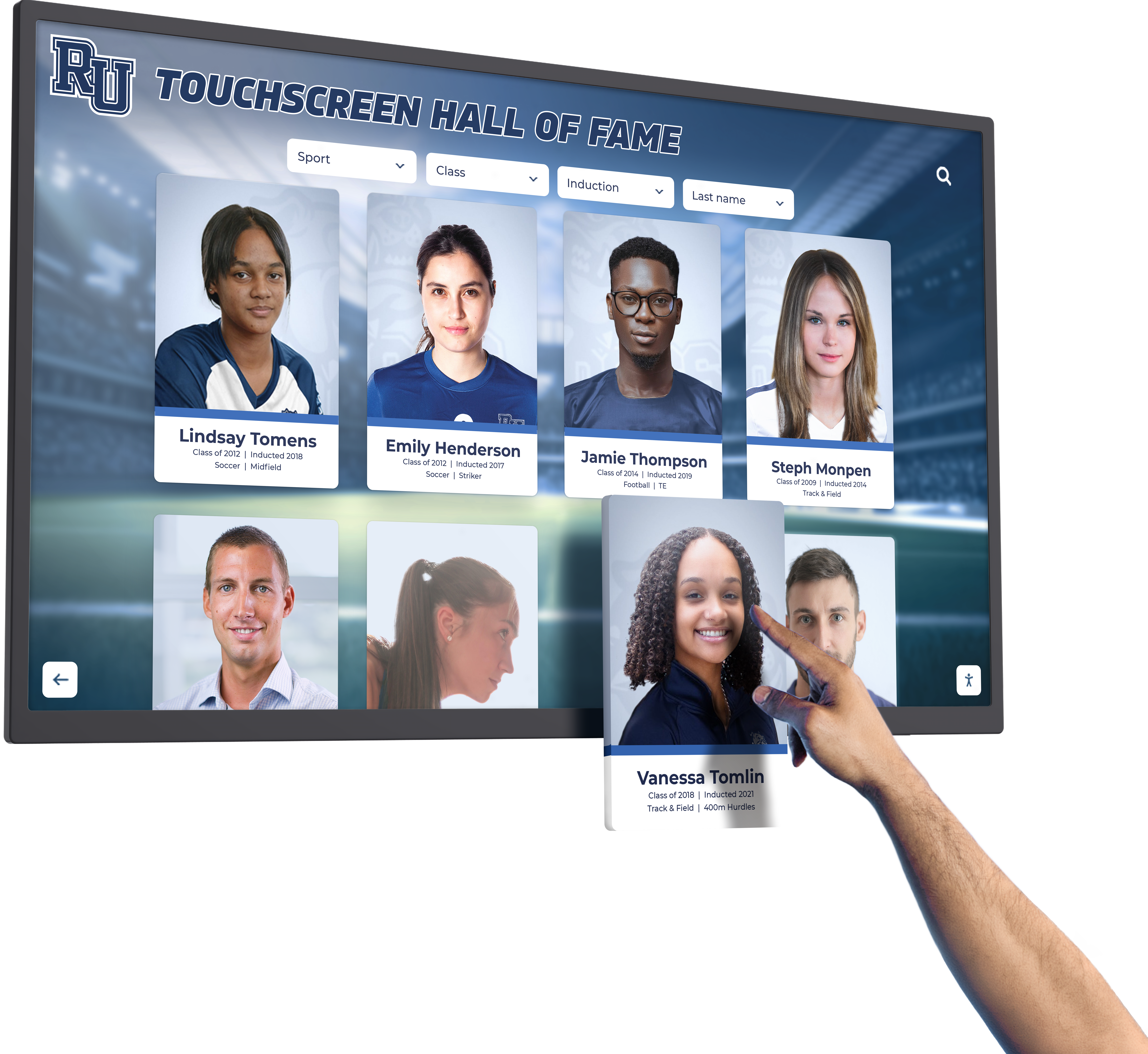Interactive boards represent powerful tools for recognition, engagement, and community building—but only when implemented thoughtfully with compelling content and features that invite exploration. Many organizations invest significantly in interactive display technology only to discover that their boards fail to capture visitor attention, with users glancing briefly before moving on without meaningful interaction.
The difference between interactive boards that gather dust and those that become community centerpieces lies not in hardware specifications or screen size, but in strategic content planning, thoughtful feature implementation, and ongoing optimization that keeps experiences fresh and relevant. Successful interactive boards combine intuitive navigation, compelling multimedia content, regular updates, and features specifically designed to encourage exploration rather than passive viewing.
This comprehensive guide presents 25+ proven interactive board suggestions across content strategy, feature implementation, user experience design, and promotional tactics. These recommendations draw from successful implementations across educational institutions, nonprofits, community organizations, and businesses that have transformed their interactive displays from underutilized technology into essential community engagement tools.
Strategic Content Suggestions for Interactive Boards
Content forms the foundation of effective interactive boards. Without compelling information to explore, even the most sophisticated technology fails to engage visitors meaningfully.
1. Develop Rich Multimedia Profiles
Transform basic text listings into immersive multimedia experiences that tell complete stories. Rather than simply displaying names and achievements, create comprehensive profiles incorporating:
Visual Elements:
- Professional portrait photography showing subjects in their contexts
- Action shots capturing memorable moments and peak performances
- Historical photos connecting past achievements to present recognition
- Photo galleries showing progression and journey over time
- Document scans preserving original certificates, letters, and artifacts
Video Content:
- Personal testimonial interviews where subjects share their stories authentically
- Achievement highlight reels showcasing memorable performances or moments
- Documentary-style mini-profiles providing biographical context and narrative
- Behind-the-scenes footage revealing preparation and dedication
- Message recordings for future generations preserving voices and perspectives
Audio Components:
- Oral history recordings capturing authentic voices and stories
- Audio descriptions providing accessibility for visually impaired visitors
- Ambient soundscapes creating emotional connection to content
- Narrated achievement summaries for those preferring audio to reading
- Music associated with specific eras or achievements
Organizations implementing multimedia recognition strategies report that video content receives 3-4x more engagement than text-only profiles, with visitors watching video segments for an average of 90-120 seconds—dramatically longer than typical text reading times.
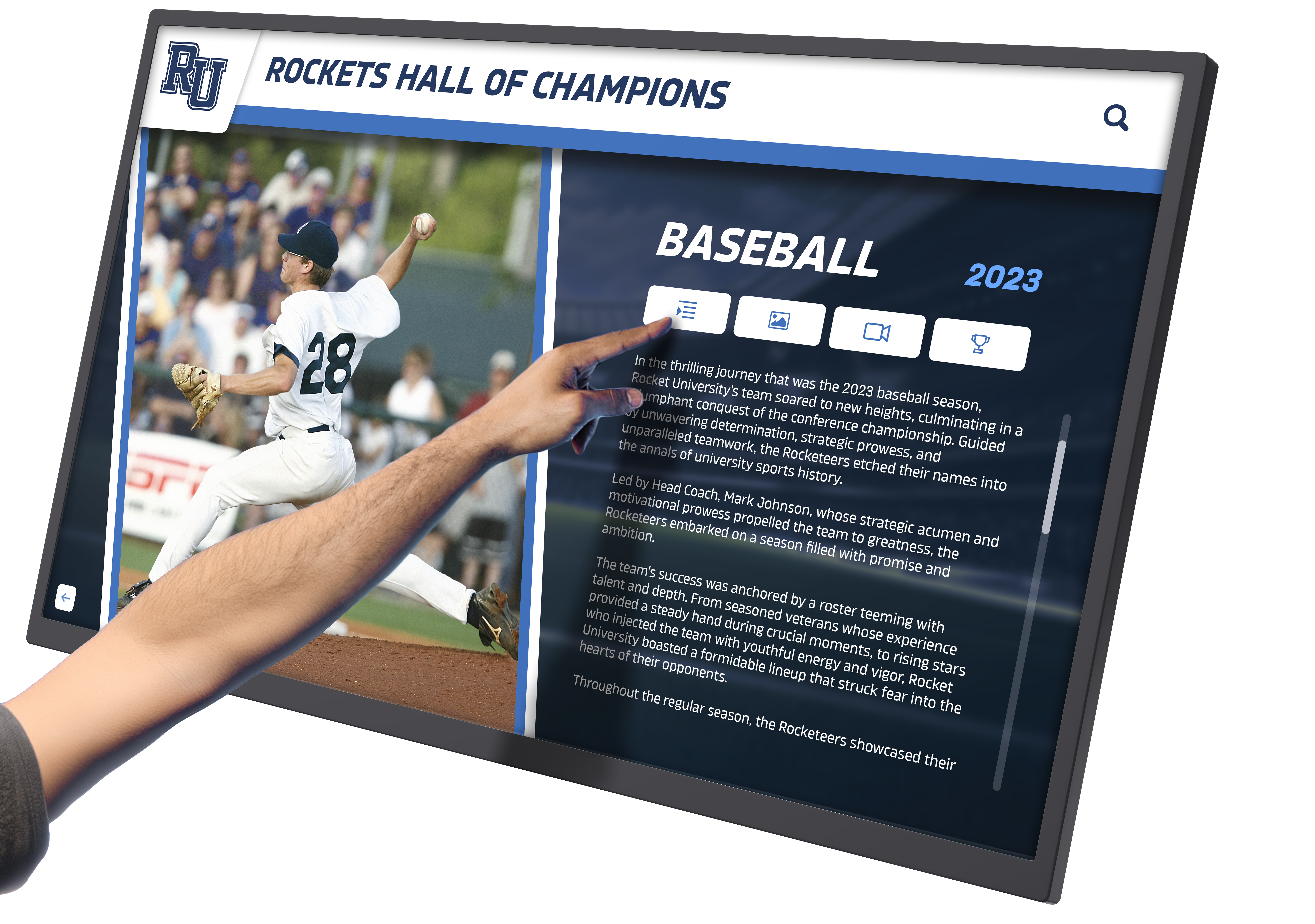
2. Create Searchable Achievement Archives
Enable visitors to find exactly what interests them through comprehensive search functionality:
Name-Based Search:
- Auto-complete suggestions appearing as users type
- Fuzzy matching accommodating spelling variations
- Maiden name and nickname recognition
- Class year associations appearing alongside names
Category Filtering:
- Achievement type (athletic, academic, service, leadership)
- Time period or decade filtering
- Organization or team affiliations
- Award types and honor levels
- Geographic connections for dispersed communities
Keyword Search:
- Full-text search across all profile content
- Tag-based discovery enabling thematic exploration
- Related content suggestions based on search patterns
- Popular search terms featured for quick access
Effective search transforms passive scrolling into active discovery, allowing visitors to immediately access content most relevant to their interests rather than hoping featured content matches their curiosity.
3. Build Thematic Content Collections
Curate related content into engaging collections that tell broader stories:
Temporal Themes:
- Decade highlights showcasing each era’s distinctive achievements
- Anniversary commemorations celebrating milestone years
- Seasonal rotations aligning content with current activities or events
- Historical progression displays showing evolution over time
Achievement Themes:
- Championship seasons bringing together title-winning teams
- Academic excellence featuring top scholars across disciplines
- Community service spotlights celebrating philanthropy and leadership
- Innovation showcases highlighting groundbreaking achievements
Demographic Themes:
- Family legacy collections featuring multi-generational achievers
- Geographic connections highlighting regional representations
- Professional pathway collections showing career progression
- Interest-based groupings connecting people through shared passions
Thematic collections create narrative coherence that individual profiles alone cannot achieve, helping visitors understand connections between achievements and the broader organizational story.
4. Incorporate User-Generated Content
Invite community members to contribute their perspectives and memories:
Memory Submissions:
- Alumni sharing favorite memories associated with recognized individuals
- Former teammates contributing stories from shared experiences
- Family members adding personal anecdotes and context
- Community members celebrating local connections
Photo Contributions:
- Crowd-sourced historical photos filling archival gaps
- Candid moments capturing personality beyond official portraits
- Reunion photos showing current connections
- Behind-the-scenes images revealing preparation and dedication
Testimonial Recordings:
- Video messages from peers celebrating achievements
- Audio memories from those who witnessed accomplishments
- Written tributes honoring impact and influence
- Congratulatory messages for recent recognitions
User-generated content transforms one-way communication into community dialogue while continuously expanding available content without requiring organizational resources.
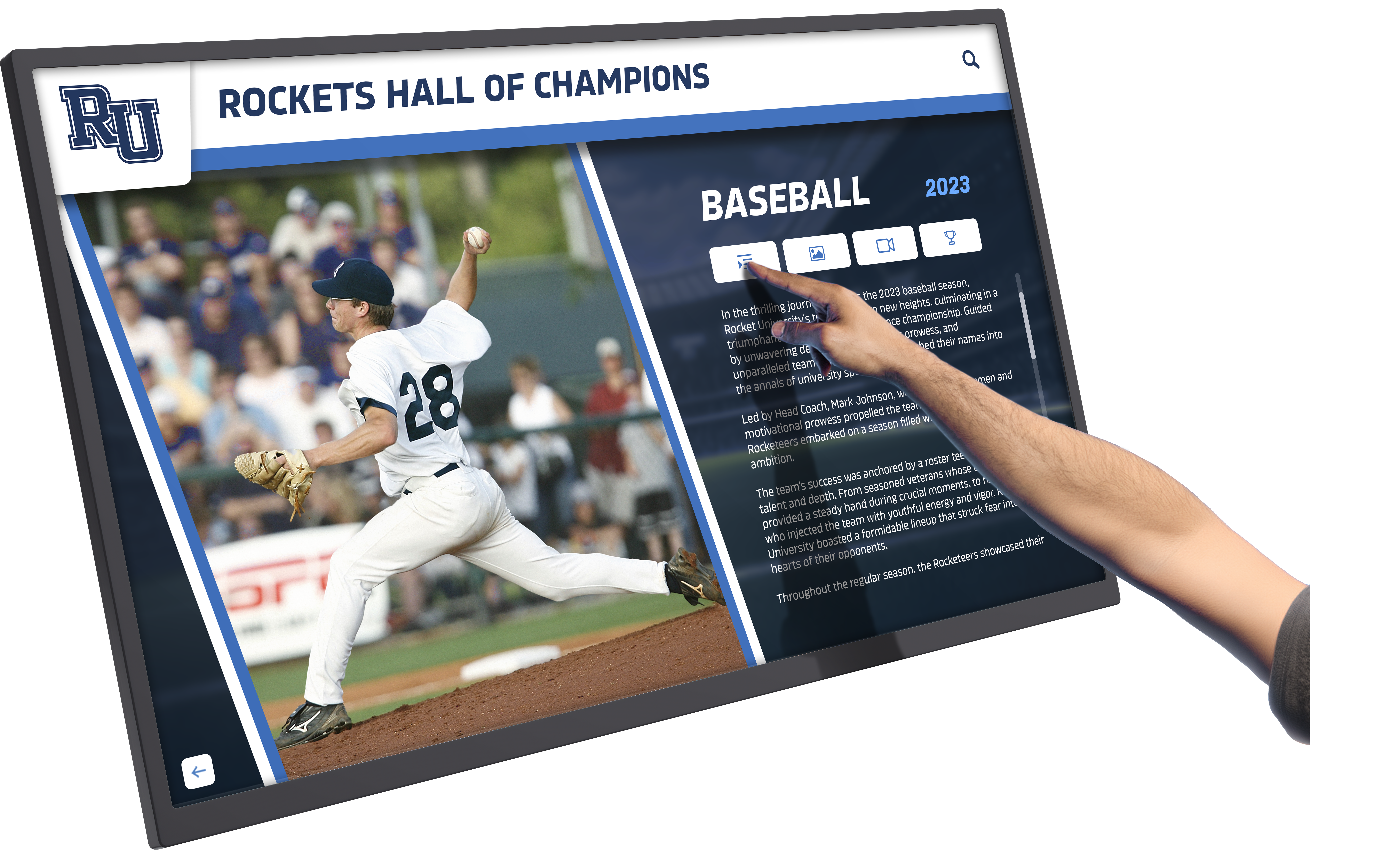
5. Feature Dynamic Home Screens
Create compelling entry points that invite exploration:
Rotating Spotlights:
- Featured achievement of the day/week highlighting different content
- Random profile presentations ensuring all content receives visibility
- Timely spotlights aligned with current events or anniversaries
- Newest additions showcasing recently added recognition
Engagement Prompts:
- “Did you know?” facts surprising visitors with interesting trivia
- Achievement challenges inviting visitors to find specific content
- Exploration suggestions guiding discovery paths
- Social proof showing most-viewed or trending content
Visual Appeal:
- High-quality imagery creating immediate visual interest
- Motion graphics attracting attention without overwhelming
- Clean design emphasizing content over decorative elements
- Consistent branding reinforcing organizational identity
Dynamic home screens prevent the stagnation that occurs when visitors see identical content on every visit, encouraging repeated interaction rather than one-time exploration.
Interactive Feature Suggestions
Beyond content itself, specific interactive features significantly impact engagement levels and user satisfaction.
6. Implement Intuitive Navigation Systems
Well-designed navigation enables effortless exploration without frustration:
Clear Visual Hierarchy:
- Primary categories immediately visible and clearly labeled
- Subcategories logically organized under parent topics
- Breadcrumb trails showing current location within structure
- Consistent placement of navigation elements across all screens
- Obvious “home” button enabling quick reset to starting point
Touch-Optimized Controls:
- Large touch targets (minimum 44x44 pixels) preventing mis-taps
- Adequate spacing between interactive elements avoiding accidental selections
- Visual feedback confirming every touch interaction
- Swipe gestures for intuitive navigation between related content
- Pinch-zoom capabilities for detailed examination of images and documents
Progressive Disclosure:
- Summary views providing overview information (5-10 seconds)
- Detailed pages offering comprehensive content (30-90 seconds)
- Deep dive options for extremely interested visitors (2-5 minutes)
- Clear visual cues indicating additional content availability
Navigation should feel so natural that first-time users explore confidently without needing instructions or assistance.
7. Add Social Sharing Capabilities
Extend recognition reach beyond physical displays:
Digital Sharing Options:
- Email-yourself features sending profile links for later exploration
- Social media sharing with pre-formatted graphics and text
- QR code generation linking to specific content on mobile devices
- Direct URL copying for easy sharing via messaging apps
Print Capabilities:
- PDF generation creating shareable documents
- Email summaries sending formatted content directly
- Print-ready certificates or achievement summaries
- Downloadable photos for personal collections
Community Features:
- Visitor comments enabling dialogue about achievements
- Reaction options allowing quick appreciation expressions
- Connection requests facilitating networking among recognized individuals
- Group message boards for cohorts or teams
Social sharing amplifies impact dramatically—each shared profile potentially reaches dozens or hundreds of people who may never physically visit the display location.
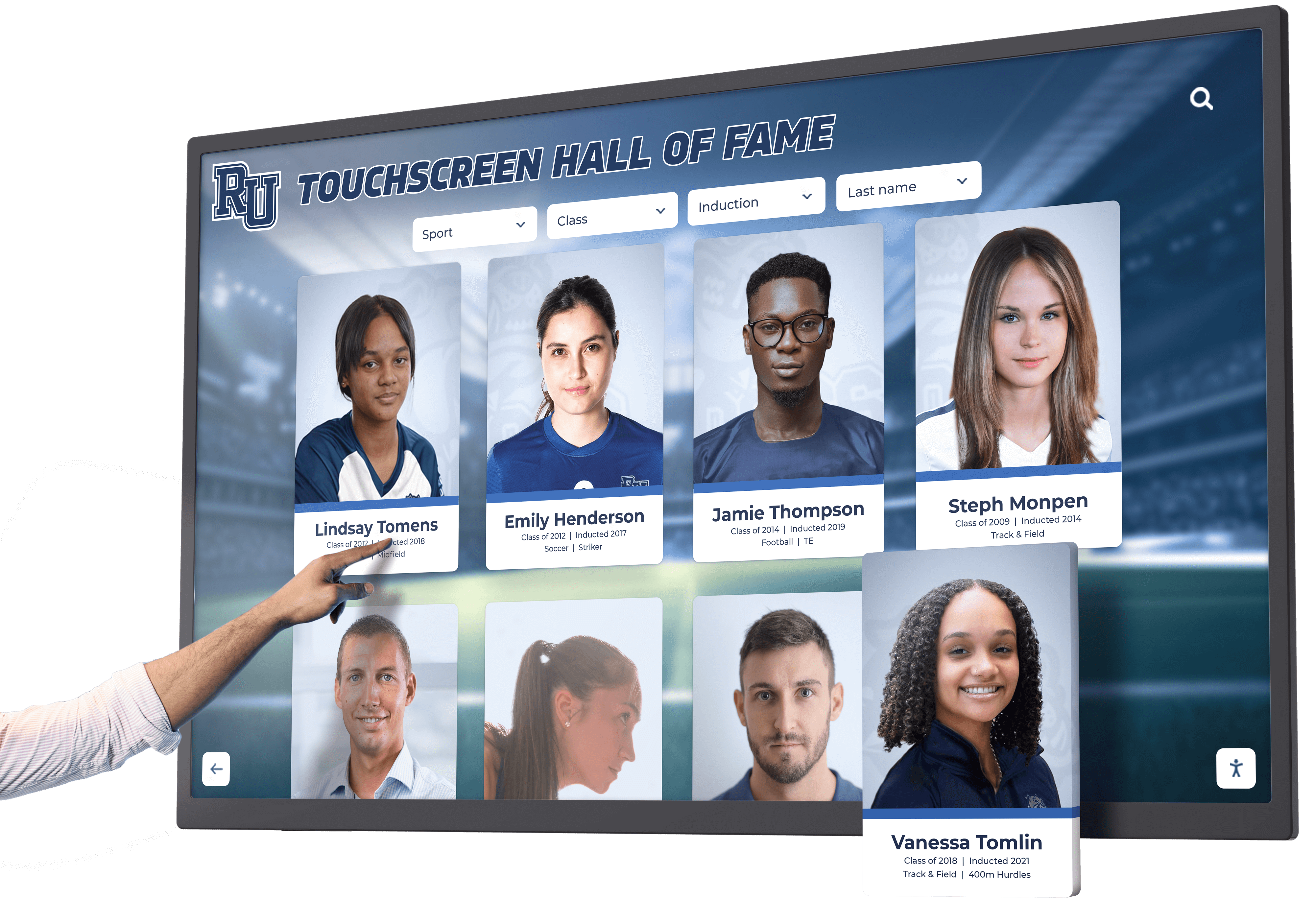
8. Integrate Gamification Elements
Thoughtfully implemented gamification increases exploration without trivializing content:
Discovery Challenges:
- Scavenger hunts encouraging visitors to find specific achievements
- Trivia questions testing knowledge about recognized individuals
- “Explore five profiles” challenges motivating breadth
- Hidden achievement Easter eggs rewarding thorough exploration
Progress Tracking:
- Visual indicators showing percentage of content explored
- Achievement badges for reaching exploration milestones
- Leaderboards showing most engaged visitors (where appropriate)
- Personal exploration histories tracking individual discovery
Interactive Quizzes:
- Knowledge tests about organizational history and achievements
- “Can you guess?” games revealing answers after user predictions
- Personality matches connecting visitors to similar recognized individuals
- Timeline challenges placing achievements in chronological order
Gamification proves particularly effective for younger audiences while maintaining appeal across demographics when implemented with appropriate tone.
9. Enable Timeline Visualizations
Help visitors understand achievements in temporal context:
Interactive Chronologies:
- Zoomable timelines spanning organizational history
- Filterable views showing specific achievement types over time
- Era comparisons highlighting different periods
- Milestone markers indicating significant events
- Media integration showing how achievements looked at the time
Progression Displays:
- Individual achievement journeys showing development over time
- Team or cohort progressions tracking collective advancement
- Organizational evolution displays documenting growth
- Before-and-after comparisons demonstrating change
Anniversary Features:
- Automatic highlighting of milestone anniversaries
- “On this day” historical achievement showcases
- Decade retrospectives celebrating ten-year marks
- Future milestone countdowns building anticipation
Timeline visualizations provide context that isolated achievement displays lack, helping visitors appreciate achievements within their historical moments.
10. Incorporate Comparison Tools
Enable visitors to explore relationships between achievements:
Side-by-Side Displays:
- Compare statistics between different individuals or teams
- Contrast achievements across different eras
- Show evolution of records over time
- Display family or legacy connections between generations
Record Progression Charts:
- Visual displays showing how records improved over decades
- Statistical comparisons across achievement categories
- Interactive graphs enabling custom comparisons
- “Then and now” features contrasting past and present
Achievement Context:
- Show how individual accomplishments relate to broader benchmarks
- Display percentile rankings where appropriate
- Provide historical context for record-breaking performances
- Compare local achievements to regional or national standards
Comparison features transform abstract numbers into meaningful context, helping visitors appreciate the significance of specific achievements.
User Experience Design Suggestions
Technical features matter less than how users experience them. Thoughtful design makes the difference between frustration and delight.
11. Optimize Touch Response Speed
Nothing frustrates users faster than laggy, unresponsive interfaces:
Performance Requirements:
- Touch response within 100 milliseconds maximum
- Immediate visual feedback confirming interaction
- Smooth scrolling without jitter or stuttering
- Quick content loading (under 2 seconds per screen)
- Seamless video playback without buffering delays
Technical Considerations:
- Adequate computing power preventing performance bottlenecks
- Content optimization reducing file sizes without quality loss
- Efficient coding minimizing processing requirements
- Regular performance monitoring identifying degradation
- Proactive maintenance preventing slowdowns
Institutions considering hardware specifications for recognition displays should prioritize responsive performance over maximum screen size when budget constraints require trade-offs.

12. Ensure Accessibility for All Users
Inclusive design serves everyone while being essential for visitors with disabilities:
Visual Accessibility:
- High contrast modes for low vision users
- Adjustable text size without breaking layouts
- Screen reader compatibility for blind users
- Colorblind-friendly palettes avoiding problematic combinations
- Clear typography with adequate spacing
Physical Accessibility:
- Wheelchair-accessible placement height and viewing angles
- Touch targets large enough for users with limited dexterity
- Alternative input methods beyond touch when possible
- Adequate time for interaction without frustrating timeouts
- Adjustable interaction speeds accommodating different abilities
Cognitive Accessibility:
- Clear, simple language avoiding unnecessary jargon
- Consistent layouts reducing cognitive load
- Logical organization making content predictable
- Forgiving interfaces accommodating mistakes without penalty
- Multiple ways to access same content serving different preferences
Digital recognition accessibility extends benefits to entire communities while demonstrating organizational values through inclusive design.
13. Create Engaging Visual Design
Aesthetics significantly impact both initial engagement and sustained interaction:
Design Principles:
- Consistent branding reinforcing organizational identity
- Strategic use of white space preventing visual overwhelm
- Thoughtful typography emphasizing hierarchy and readability
- Color schemes matching brand guidelines while ensuring visibility
- Professional photography creating immediate visual appeal
Motion and Animation:
- Subtle animations confirming interactions without distraction
- Smooth transitions between screens maintaining spatial context
- Loading animations indicating progress during longer processes
- Attract-mode animations drawing attention when idle
- Restrained motion graphics enhancing without overwhelming
Content Presentation:
- Grid layouts organizing information logically
- Card-based designs creating clear content boundaries
- Prominent imagery leading with visual appeal
- Scannable text layouts supporting quick comprehension
- Progressive disclosure revealing complexity gradually
Quality visual design creates positive first impressions that encourage deeper exploration rather than immediate abandonment.
14. Implement Smart Content Recommendations
Help visitors discover content they wouldn’t find through browsing alone:
Algorithmic Suggestions:
- “Visitors who viewed this also explored” recommendations
- Related content based on shared characteristics or connections
- Personalized suggestions based on current viewing history
- Intelligent next-content proposals guiding exploration journeys
Contextual Connections:
- Highlight family members and legacy connections
- Show teammate relationships and shared experiences
- Connect mentors with protégés across generations
- Display geographic connections for dispersed visitors
Serendipitous Discovery:
- Random profile features introducing unexpected finds
- “You might also like” suggestions broadening exploration
- Thematic collection recommendations based on interest signals
- Automatic rotation preventing repetitive experiences
Smart recommendations increase both engagement duration and breadth of exploration, helping visitors discover the full richness of recognition content.
15. Design for Various Interaction Modes
Different visitors approach interactive boards with different intentions and time constraints:
Quick Browse Mode:
- Highlight features enabling rapid overview
- Thumbnail galleries supporting quick scanning
- Key facts immediately visible without detailed navigation
- Express search for visitors seeking specific content
Focused Research Mode:
- Detailed search with advanced filtering
- Complete profile information readily accessible
- Related content easily discoverable
- Save and bookmark features for extended research
Casual Exploration Mode:
- Suggested discovery paths guiding engagement
- Interesting facts and trivia maintaining attention
- Gamification elements making exploration playful
- Social features encouraging sharing and discussion
Passive Viewing Mode:
- Attract loops playing automatically when idle
- Slideshow features requiring no interaction
- Auto-advancing content for distant viewing
- Large text and imagery visible from greater distances
Designing for multiple modes ensures the interactive board serves diverse visitor needs effectively rather than optimizing for a single use case.
Content Management and Update Suggestions
Even excellent initial content grows stale without strategic refresh and enhancement.
16. Establish Regular Update Schedules
Predictable refresh cycles give visitors reasons to return:
Update Frequencies:
- Daily: Featured content rotation highlighting different individuals
- Weekly: New spotlight selections and discovery challenges
- Monthly: Recent achievement additions and profile enhancements
- Quarterly: Thematic collection launches and major content campaigns
- Annually: Historical expansion projects and interface refinements
Content Enhancement Pipeline:
- Basic profiles created immediately upon recognition decisions
- Enhanced content added within 30-60 days through systematic enrichment
- Premium multimedia produced within 90-180 days for selected profiles
- Ongoing refinement based on engagement analytics and feedback
Promotional Cycles:
- Regular communications announcing content additions
- Social media highlighting new features and profiles
- Event integration showcasing relevant recognition
- Anniversary celebrations featuring milestone achievements
Institutions exploring content management strategies benefit from systematic approaches rather than treating updates as ad hoc projects completed only when time allows.

17. Crowd-Source Content Discovery
Leverage community knowledge to enhance recognition depth:
Identification Campaigns:
- “Can you identify?” initiatives for historical photos
- Missing information appeals for incomplete profiles
- Verification requests confirming questionable details
- Connection discovery asking about relationships between individuals
Story Collection:
- Memory submission campaigns gathering anecdotes
- Impact testimonials from those influenced by recognized individuals
- Historical context from those who witnessed achievements
- “Where are they now?” updates tracking current status
Content Contribution:
- Photo donation drives digitizing personal collections
- Document scanning projects preserving artifacts
- Video submission invitations capturing testimonials
- Audio recording sessions preserving oral histories
Community contributions extend organizational capacity while building engagement through participatory recognition development.
18. Create Seasonal Content Themes
Align recognition with natural annual rhythms:
Academic Calendar Alignment:
- Beginning-of-year orientations featuring incoming class connections
- Homecoming celebrations highlighting returning alumni
- Championship seasons showcasing current competitive success
- Graduation periods honoring academic achievement
- Reunion weekends featuring class-specific content
Cultural and Civic Moments:
- Heritage month celebrations featuring relevant achievements
- Community events aligning with local traditions
- National recognition days connecting to broader movements
- Anniversary commemorations of historical milestones
Campaign Integration:
- Fundraising campaign alignment featuring related donors
- Giving day promotions highlighting philanthropic recognition
- Recruitment periods showcasing impressive achievements
- Awareness campaigns connecting to mission priorities
Seasonal theming maintains relevance and gives regular visitors changing content throughout annual cycles.
19. Implement A/B Testing Strategies
Data-driven optimization identifies what actually works rather than relying on assumptions:
Testing Candidates:
- Homepage layout variations comparing engagement metrics
- Navigation structure alternatives measuring findability
- Content formats contrasting video versus text performance
- Call-to-action variations testing different prompts
- Featured content selection comparing interest levels
Measurement Approaches:
- Split-screen display testing showing different experiences simultaneously
- Time-based testing alternating versions on schedule
- Cohort comparisons segmenting by visitor type
- Analytics review examining behavioral differences
- Survey collection gathering qualitative feedback
Implementation Cycles:
- Hypothesis development based on goals and observations
- Test design creating valid comparison conditions
- Data collection over adequate sample sizes
- Analysis determining statistical significance
- Implementation of winning approaches
- Continuous iteration improving incrementally
Organizations measuring digital recognition display effectiveness through systematic testing achieve significantly better engagement than those relying on intuition alone.
20. Preserve and Showcase Historical Content
Historical depth creates context while honoring legacy:
Digitization Projects:
- Scanning historical photos, documents, and artifacts
- Converting physical plaques to digital profiles
- Preserving deteriorating media before loss
- Organizing archives into accessible digital collections
Historical Narrative Development:
- Chronological organization showing evolution over time
- Era-specific design treatments matching historical periods
- Contextual information explaining historical significance
- Then-and-now comparisons connecting past and present
Legacy Connection:
- Multi-generational family showcases
- Mentor-protégé relationship highlights
- Tradition evolution displays
- Founding achievement recognition
For organizations with extensive physical recognition requiring conversion, resources about digitizing plaques and trophies provide systematic approaches ensuring nothing gets lost in the transition.
Promotional and Engagement Suggestions
Even excellent interactive boards require strategic promotion to achieve their engagement potential.
21. Integrate with Existing Programs
Connect recognition displays to established activities:
Event Integration:
- Recognition ceremonies featuring honorees on interactive boards
- Tours highlighting the board as a destination
- Alumni gatherings using recognition as conversation starter
- Fundraising events leveraging recognition for inspiration
Educational Connections:
- Classroom assignments requiring research using the board
- Student projects contributing content to recognition displays
- Historical studies exploring achievement evolution
- Career exploration connecting past achievements to current pathways
Communication Channels:
- Newsletter features spotlighting content additions
- Social media campaigns highlighting interesting profiles
- Website integration embedding recognition content
- Email campaigns targeting specific stakeholder groups
Strategic integration ensures the interactive board becomes woven into organizational fabric rather than remaining a standalone feature.
22. Create Exploration Incentives
Motivate thorough engagement through structured challenges:
Recognition Programs:
- Certificates or badges for completing exploration milestones
- Prize drawings for visitors who engage deeply
- Recognition of top explorers on leaderboards
- Social acknowledgment of participation
Scavenger Hunts:
- Specific profile discovery challenges
- Hidden information finding contests
- Connection identification puzzles
- Trivia questions answered through exploration
Competitions:
- Most profiles explored in timeframe
- Fastest discovery of specific achievements
- Most comprehensive knowledge demonstration
- Creative content contribution contests
Incentives prove particularly effective during launch periods when building initial awareness and establishing engagement habits.
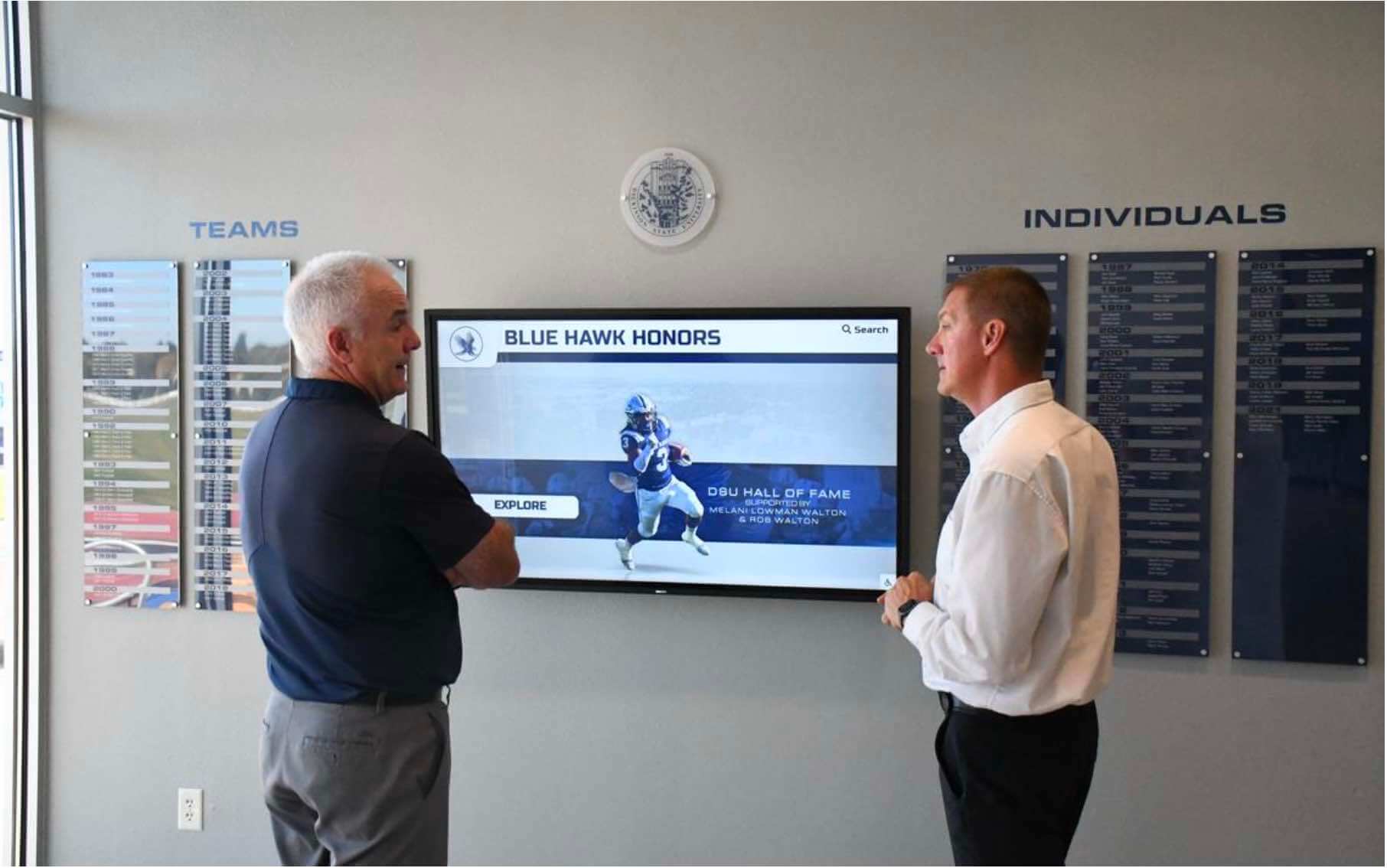
23. Leverage Social Proof and Testimonials
Use positive experiences to attract new engagement:
Testimonial Collection:
- Video recordings of visitors praising the experience
- Written feedback displayed prominently
- Social media post aggregation showing enthusiasm
- Alumni testimonials describing emotional impact
Usage Statistics:
- “Join [X] visitors who have explored” messaging
- Most-viewed content highlighting popular profiles
- Engagement milestones celebrating community participation
- Growth metrics demonstrating increasing adoption
Influencer Engagement:
- Featured individuals promoting their own profiles
- Recognized alumni encouraging exploration
- Community leaders endorsing the resource
- Student ambassadors demonstrating engagement
Social proof reduces hesitation and creates momentum by demonstrating that others find value in interaction.
24. Develop Companion Mobile Experiences
Extend recognition beyond physical display locations:
Mobile Web Access:
- Responsive website providing full content access
- Mobile-optimized navigation for smaller screens
- Touch-optimized controls for smartphone interaction
- Offline capabilities for intermittent connectivity
Mobile App Features:
- Push notifications announcing content additions
- Saved favorites synchronizing across devices
- Augmented reality features overlaying information
- Location-based notifications near physical displays
QR Code Bridges:
- Codes on physical display linking to mobile content
- Print materials driving mobile exploration
- Signage throughout facilities promoting access
- Business cards and promotional materials with codes
Mobile extension dramatically increases accessibility while accommodating contemporary expectations for anytime, anywhere information access.
25. Host Launch Events and Ongoing Programming
Create programming around the interactive board itself:
Launch Celebrations:
- Grand opening events unveiling the display
- Recognition ceremonies honoring featured individuals
- Media invitations generating coverage
- VIP previews for major stakeholders
Ongoing Events:
- Monthly spotlight receptions featuring specific honorees
- Historical presentation series exploring achievements
- Panel discussions with recognized individuals
- Family reunion facilitation bringing together connections
Educational Programming:
- Speaker series featuring achievement stories
- Skill-building workshops inspired by recognized excellence
- Mentorship program launches connecting generations
- Career exploration sessions using recognition for inspiration
Regular programming maintains attention and creates predictable opportunities for community engagement centered on recognition.
Advanced Technology Suggestions
Emerging capabilities enable increasingly sophisticated recognition experiences.
26. Implement Voice Control and Audio Interaction
Voice interfaces add accessibility while enabling hands-free exploration:
Voice Capabilities:
- Natural language search through spoken queries
- Voice-activated navigation for hands-free control
- Audio content playback with voice commands
- Multiple language support expanding accessibility
- Voice recording enabling spoken testimonials
Audio Features:
- Text-to-speech reading all content aloud
- Audio descriptions narrating visual content
- Podcasts-style extended content for audio consumption
- Ambient soundscapes creating emotional context
- Historical audio recordings preserved and featured
Voice interaction particularly benefits visually impaired visitors while proving convenient for all users.
27. Add Data Visualization and Analytics Displays
Help visitors understand recognition patterns and trends:
Statistical Displays:
- Achievement distribution charts across categories
- Geographic representation maps showing origins
- Temporal trend graphs displaying patterns over time
- Demographic breakdowns where appropriate
- Comparative statistics contextualizing achievements
Interactive Data Exploration:
- Zoomable and filterable visualizations
- Drill-down capabilities exploring details
- Custom query builders for visitor-defined views
- Export capabilities enabling further analysis
- Real-time updates reflecting current data
Data visualization transforms individual achievements into broader patterns revealing organizational identity and evolution.
28. Integrate Artificial Intelligence Enhancements
AI technologies enable personalization and automation:
Content Generation:
- Automated biography writing from structured data
- Photo enhancement improving historical images
- Video editing creating highlight compilations
- Translation services expanding language accessibility
- Content summarization creating multiple length versions
Personalization Features:
- Intelligent content recommendations based on behavior
- Adaptive interfaces adjusting to user preferences
- Predictive search anticipating intended queries
- Custom exploration paths matching interests
- Personalized digest creation based on engagement
Operational Automation:
- Automatic content organization and tagging
- Quality assurance identifying incomplete profiles
- Engagement anomaly detection flagging issues
- Content gap identification suggesting additions
- Update scheduling optimizing refresh timing
Organizations exploring emerging recognition technology trends position themselves to leverage new capabilities as they mature.
Implementation Planning Suggestions
Strategic planning ensures suggestions translate into successful reality.
29. Start with Pilot Programs
Test approaches before full-scale implementation:
Pilot Strategies:
- Single location implementation before broader rollout
- Limited content depth initially with expansion plan
- Phased feature introduction rather than all-at-once
- Small user group testing before public launch
- Controlled budget with success-dependent expansion
Learning Approaches:
- Structured feedback collection from pilot users
- Analytics review identifying usage patterns
- Usability testing revealing friction points
- Stakeholder input gathering diverse perspectives
- Iterative refinement based on observations
Decision Criteria:
- Engagement thresholds determining success
- Technical performance benchmarks
- User satisfaction metrics
- Operational sustainability assessment
- ROI calculations informing expansion decisions
Pilots reduce risk while enabling learning that improves eventual full implementations.
30. Build Cross-Functional Implementation Teams
Successful interactive boards require diverse expertise:
Team Composition:
- Technology staff handling technical implementation
- Content specialists developing recognition material
- Design professionals ensuring quality presentation
- Stakeholder representatives providing community perspective
- Leadership ensuring strategic alignment
Role Definition:
- Clear responsibility assignment preventing gaps
- Decision authority establishment enabling progress
- Communication protocols maintaining coordination
- Timeline accountability keeping projects on track
- Resource allocation ensuring adequate support
Ongoing Governance:
- Regular update meetings reviewing progress
- Issue escalation paths resolving blockers quickly
- Success metric monitoring tracking outcomes
- Budget oversight maintaining fiscal responsibility
- Strategic guidance adapting to changing conditions
Cross-functional teams ensure interactive boards serve institutional priorities while maintaining technical excellence and operational sustainability.
Choosing the Right Technology Partner
Platform selection fundamentally determines long-term success and satisfaction.
Key Evaluation Criteria
Platform Capabilities:
- Intuitive content management requiring minimal technical expertise
- Rich interactive features enabling engaging experiences
- Robust analytics revealing usage patterns and opportunities
- Regular updates introducing new capabilities
- Comprehensive support ensuring long-term success
Integration Options:
- Data system connections reducing duplicate entry
- Website embedding extending recognition reach
- Social media integration amplifying visibility
- Mobile app support providing anytime access
- API availability enabling custom enhancements
Service and Support:
- Responsive technical assistance when issues arise
- Training programs empowering internal teams
- Content development services supporting launches
- Strategic consulting optimizing implementations
- Long-term partnership approach rather than transactional relationships
Solutions like Rocket Alumni Solutions provide purpose-built interactive recognition platforms designed specifically for institutional needs rather than generic digital signage systems adapted for recognition purposes. Purpose-built solutions deliver superior functionality, features addressing unique recognition requirements, and support from teams understanding institutional contexts and priorities.
Conclusion: From Suggestions to Success
Implementing these interactive board suggestions transforms recognition displays from underutilized technology into essential community engagement tools that celebrate achievement, strengthen connections, and inspire excellence. Success requires moving beyond basic implementations toward strategic, content-rich, continuously optimized experiences that give visitors compelling reasons to explore deeply and return regularly.
The most effective interactive boards view these suggestions not as optional enhancements but as essential components of comprehensive recognition strategies. They combine compelling multimedia content, intuitive interactive features, thoughtful user experience design, strategic promotional integration, and sustained commitment to ongoing optimization—creating experiences that honor those recognized while serving broader institutional priorities around engagement, pride, and community building.
Organizations implementing interactive recognition displays thoughtfully discover that investment returns extend far beyond the technology itself. Enhanced recognition visibility strengthens culture, deeper engagement builds stronger communities, improved accessibility ensures inclusive celebration, operational efficiencies reduce long-term costs, and flexibility enables continuous improvement rather than static installations that become obsolete.
Ready to transform your recognition approach through interactive board technology? Modern platforms like Rocket Alumni Solutions provide the tools, features, and support necessary to implement these suggestions successfully—combining sophisticated technology with intuitive management that empowers organizations to create and maintain exceptional recognition experiences serving communities for years to come.
